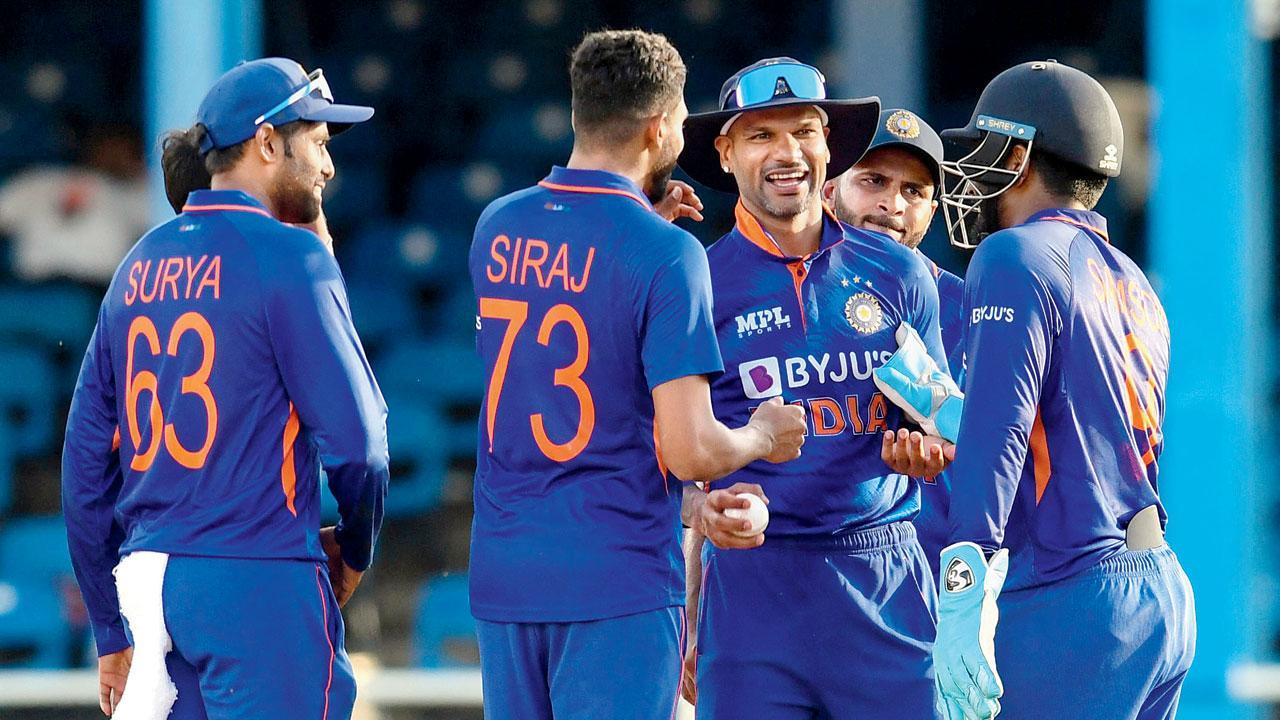If played well, the 50-over game is a good cricket match and rewarding in its entertainment value. These are generally the sentiments of older players who knew only 2 formats. Current players often place the IPL in particular and T20 in general at the top of the list when it comes to satisfaction

India players celebrate a West Indies wicket during the third ODI at Port of Spain, Trinidad and Tobago, last month. PIC/AFP
 I’m reading a fascinating book—Extraterrestrial—which poses a substantial question that should also be applied to cricket. Author Avi Loeb is a decorated Harvard science professor who poses a tantalising question; “Imagine life on our planet the day after there is irrefutable confirmation of life elsewhere in the universe.” That provocative thought leads to an obvious question—what is the future of cricket? That debate should’ve been held long ago. It’s not too late now, but the list of attendees has grown along with the relative strength of the women’s game and the substantial influence of climate change. Playing styles have changed drastically in a few decades and yet there is still no blueprint for cricket’s future. Much as it did during the World Series Cricket (WSC) insurrection of the 1970s, the administration lurches ahead, driven mainly by knee-jerk reaction.
I’m reading a fascinating book—Extraterrestrial—which poses a substantial question that should also be applied to cricket. Author Avi Loeb is a decorated Harvard science professor who poses a tantalising question; “Imagine life on our planet the day after there is irrefutable confirmation of life elsewhere in the universe.” That provocative thought leads to an obvious question—what is the future of cricket? That debate should’ve been held long ago. It’s not too late now, but the list of attendees has grown along with the relative strength of the women’s game and the substantial influence of climate change. Playing styles have changed drastically in a few decades and yet there is still no blueprint for cricket’s future. Much as it did during the World Series Cricket (WSC) insurrection of the 1970s, the administration lurches ahead, driven mainly by knee-jerk reaction.
T20, the headline format
In the 1970s, the WSC insurrection was over pay and conditions, but it was the 50-over game that eventually prospered. Now, T20 is the headline format with Test cricket receiving occasional favourable mentions from players. The England captain Ben Stokes recently announced his retirement from the 50-over game. A reluctant Stokes said it was not possible for him to compete in all three formats and while his retirement was not unexpected, it is nevertheless a concern.
Played well, the 50-over game is a good cricket match and rewarding in its entertainment value. Those are generally the sentiments of older players who knew only two formats. Current players often place the IPL in particular and T20 in general at the top of the list when it comes to satisfaction. This is why the future of the game needs thoughtful consideration. A firm decision is needed on how many playing formats are best for cricket. Once that is decided, it then needs to be confirmed how the formats should move ahead to ensure the game evolves.
Also Read: IOC to consider cricket’s inclusion for 2028 LA Olympics
Any positive promotion of the game should be done hand-in-hand with the players and this includes women cricketers. An international Players Association (containing a verified Indian contingent) should be a mandatory part of cricket’s future. In nearly 50 years, the game has developed from being semi-amateur to a fully-fledged professional endeavour. The administrators can’t have imagined the enormous power they were conceding to the players when they unleashed what’s become an incredibly lucrative T20 circuit.
Cricket dabbling with T10 too
Cricket’s history needs to be carefully considered before a firm decision is made on the future pathway. The limited overs game evolved because of a perceived boredom with Test cricket. Then T20 grew rapidly on the back of the supposed stagnation in 50-overs cricket. This begs the question; what happens if fans become bored with the 20-over game? Cricket is already dabbling with T10 leagues and it’s not hard to imagine the game embracing more of that format. T10 should be regarded as over-doing the entertainment quotient and not a format the professional players should embrace. Even T20 with its tendency towards a power game and lasting only 40 overs at best, can often be unfulfilling for a player. Fielding is an enjoyable part of cricket, but not so much if, as a batsman, you are facing very few deliveries. However, it is understandable that a current player—needing to provide for his family—is comfortable earning a good living from the shorter game.
This version suits many young cricketers as the skills can be developed more quickly than those required for the lengthy formats. The future of the game is in the hands of younger players. However, they need to balance future decisions with one eye on the past. The balance is a delicate one, but the game needs to hear informed opinions before making a decision on where cricket is heading. That is why the administrators should’ve organised an all-encompassing debate long ago. As an intriguing Loeb indicates in his book—it’s crucial that those involved are prepared for what lies ahead.
 Subscribe today by clicking the link and stay updated with the latest news!" Click here!
Subscribe today by clicking the link and stay updated with the latest news!" Click here!










